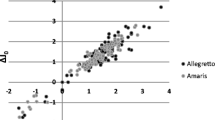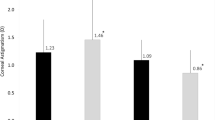Abstract
To observe and calculate the unevenness and the non-orthogonal state of distribution of corneal thickness and the relationship between them using Pentacam and to investigate the influence of unevenness and the non-orthogonal state on correction of myopic astigmatism by laser subepithelial keratomileusis (LASEK). 230 eyes with myopic astigmatism treated with LASEK were divided into two groups: 114 eyes as the low astigmatism group (−0.25 to −0.75 DC) and 116 eyes as the midrange-high astigmatism group (−1.00 to −4.50 DC). With the help of the diagram of keratoconus evaluation program of the Pentacam, the D 3.0 and D 6.5 were calculated for the index of distribution of unevenness of the corneal thickness, and the absolute value of the angle between the maximum and minimum progression-index orientation (M 90) for the index of non-orthogonal states. The correction of myopic astigmatism by LASEK was based on standard vector analysis and power vector analysis. The follow-up period was for 3 months. The preoperative M 90 was 22.14° ± 20.87°, D 6.5 was 58.66 ± 21.32 μm, and D 3.0 was 16.11 ± 4.28 μm for the 230 eyes that were tested. The D 6.5 of low astigmatism group (55.62 ± 20.81) μm was significantly lower than that of midrange-high astigmatism group (61.65 ± 21.48) μm (P < 0.05). Of the 230 eyes, the M 90 was positively correlated with D 6.5 (r = 0.37, P < 0.001), and D 6.5 was positively correlated with D 3.0 (r = 0.56, P < 0.001). 3 months postoperatively, the absolute error vector (|EV|) of low astigmatism group (0.46 ± 0.34) was significantly lower than that of midrange-high astigmatism group (0.53 ± 0.29) (P < 0.01). The error of magnitude of low astigmatism group (−0.10 ± 0.31) was significantly lower than that of midrange-high astigmatism group (0.08 ± 0.41) (P < 0.001). The absolute error of angle (|EA|) of low astigmatism group (26.10 ± 27.24) was significantly higher than that of midrange-high astigmatism group (9.99 ± 17.32) (P < 0.001). The correction ratio of low astigmatism group (1.45 ± 1.21) was significantly higher than that of midrange-high astigmatism group (0.94 ± 0.33) (P < 0.01). The error ratio (ER) of low astigmatism group (1.34 ± 1.40) was significantly higher than that of midrange-high astigmatism group (0.42 ± 0.27) (P < 0.001). In low astigmatism group, M 90 was positively correlated with |EV| (r = 0.30, P < 0.001). In midrange-high astigmatism group, M 90 was positively correlated with ER (r = 0.31, P < 0.001) and D 6.5 was positively correlated with |EV| and B, respectively (r = 0.34, 0.33, P < 0.001). The relationship between unevenness and non-orthogonal state of distribution of corneal thickness could influence the correction of astigmatism by LASEK. Therefore, more attention should be paid to the correction of midrange-high astigmatism group by excimer surgery.






Similar content being viewed by others
References
Qian, Y. S., Huang, J., Liu, R., Chu, R. Y., Xu, Y., Zhou, X. T., et al. (2011). Influence of internal optical astigmatism on the correction of myopic astigmatism by LASIK. Journal of Refractive Surgery, 27(12), 863–868.
Wolffsohn, J. S., Bhogal, G., & Shah, S. (2011). Effect of uncorrected astigmatism on vision. Journal of Cataract & Refractive Surgery, 37(3), 454–460.
Ho, J. D., Tsai, C. Y., Liou, S. W. (2009). Accuracy of corneal astigmatism estimation by neglecting the posterior corneal surface measurement. American Journal of Ophthalmology 147(5), 788–795, 795 e781–782.
Alpins, N., Ong, J. K., & Stamatelatos, G. (2012). New method of quantifying corneal topographic astigmatism that corresponds with manifest refractive cylinder. Journal of Cataract & Refractive Surgery, 38(11), 1978–1988.
Eydelman, M. B., Drum, B., Holladay, J., Hilmantel, G., Kezirian, G., Durrie, D., et al. (2006). Standardized analyses of correction of astigmatism by laser systems that reshape the cornea. Journal of Refractive Surgery, 22(1), 81–95.
Thibos, L. N., & Horner, D. (2001). Power vector analysis of the optical outcome of refractive surgery. Journal of Cataract & Refractive Surgery, 27, 80–85.
Liu, Z., Huang, A. J., & Pflugfelder, S. C. (1999). Evaluation of corneal thickness and topography in normal eyes using the Orbscan corneal topography system. British Journal of Ophthalmology, 83(7), 774–778.
McAlinden, C., Khadka, J., & Pesudovs, K. (2011). A comprehensive evaluation of the precision (repeatability and reproducibility) of the Oculus Pentacam HR. Investigative Ophthalmology & Visual Science, 52(10), 7731–7737.
Chen, Y. G. (2011). Paying more attention on the effects of excimer laser corneal refractive surgeries on the corneal biomechanical integrality. Zhonghua Yan Ke Za Zhi, 47(7), 577–579.
Acknowledgment
This study was supported by Grant No. 11204277 from the National Natural Science Foundation of China.
Author information
Authors and Affiliations
Corresponding author
Additional information
Shulin Wang and Xin Wang have contributed equally to this paper.
Rights and permissions
About this article
Cite this article
Wang, S., Wang, X., Liu, M. et al. The Unevenness and Non-orthogonal State of Distribution of Corneal Thickness and the Influence on Correction of Myopic Astigmatism by LASEK. Cell Biochem Biophys 73, 35–40 (2015). https://doi.org/10.1007/s12013-015-0571-2
Published:
Issue Date:
DOI: https://doi.org/10.1007/s12013-015-0571-2




